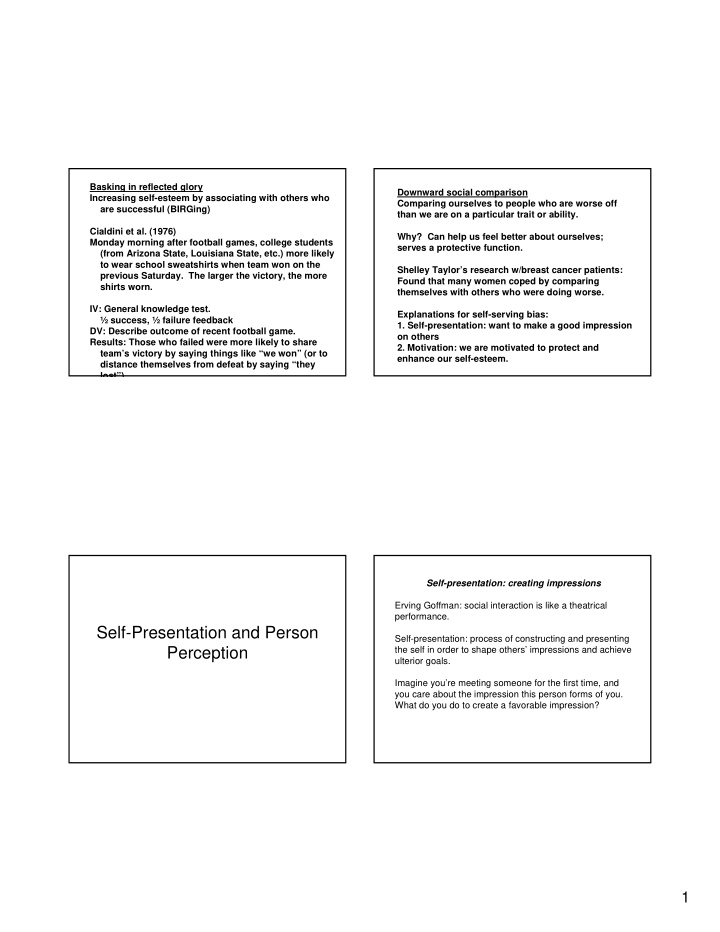



Basking in reflected glory Downward social comparison Increasing self-esteem by associating with others who Comparing ourselves to people who are worse off are successful (BIRGing) than we are on a particular trait or ability. Cialdini et al. (1976) Why? Can help us feel better about ourselves; Monday morning after football games, college students serves a protective function. (from Arizona State, Louisiana State, etc.) more likely to wear school sweatshirts when team won on the Shelley Taylor’s research w/breast cancer patients: previous Saturday. The larger the victory, the more Found that many women coped by comparing shirts worn. themselves with others who were doing worse. IV: General knowledge test. Explanations for self-serving bias: ½ success, ½ failure feedback 1. Self-presentation: want to make a good impression DV: Describe outcome of recent football game. on others Results: Those who failed were more likely to share 2. Motivation: we are motivated to protect and team’s victory by saying things like “we won” (or to enhance our self-esteem. distance themselves from defeat by saying “they lost”) Self-presentation: creating impressions Erving Goffman: social interaction is like a theatrical performance. Self-Presentation and Person Self-presentation: process of constructing and presenting Perception the self in order to shape others’ impressions and achieve ulterior goals. Imagine you’re meeting someone for the first time, and you care about the impression this person forms of you. What do you do to create a favorable impression? 1
Self-presentational strategies Person perception: forming social judgments Self-promotion Person perception: Process by which we come to know Exemplification about other people’s temporary states and enduring Modesty dispositions Intimidation •Two parts: impression formation and attribution Supplication Sandbagging Ingratiation Impression formation: rapid assessment of salient characteristics (from various sources) into an overall judgment Integrating traits into a coherent impression Anderson (1968) Summation model: Valences are added up Got ratings of desirability of hundreds of traits and Averaging model: Valences are averaged categorized them: favorable, moderately favorable, moderately unfavorable, unfavorable Participants read descriptions of target individuals using different combinations of traits IV: Trait pairing (favorable only, favorable + moderately favorable). DV: Liking ratings Result: Adding moderately favorable = less likable (averaging model) 2
Information integration theory Asch: Central and peripheral traits 1. Personal dispositions of perceiver (personal chronic constructs, priming/accessibility, mood) Kelley (1950) Introduced guest lecturer for psychology class 2. Weighted average of target’s traits (trait negativity bias) IV: Trait descriptor used (warm or cold) DV: Student ratings, observed frequency of student participation Result: Ratings were more favorable and students participated more when speaker was introduced as “warm” Primacy effect: Earlier information carries more weight than later information How do we make attributions about social behavior? Dispositional versus situational attributions Jones et al. (1968) Do people make attributions in a logical, rational Confederate is taking 30-item test of intellectual ability. way? Or, do we make some consistent errors? Experimenter announced after each question whether right/wrong. Always 15 right, 15 wrong Fundamental attribution error Actor-observer bias IV: Order of right/wrong questions. In one condition, most of the right answers are given in the first half of the “test.” Other Causal attributions: People’s explanations about the condition opposite (most right answers in second half). causes of their own or another person’s behavior. DV: Intelligence rating, Likelihood of performing well on a retest. How do people explain another’s behavior? What kinds of errors do people typically make when Result: Ratings were higher when correct answers came explaining their own and others’ behavior, and what mainly from first half (earlier information) are the consequences of those errors? 3
Fundamental attribution error: the tendency for people to underestimate the impact of situational causes and to overestimate the impact of dispositional causes in explaining another person’s behavior. Actor-observer difference: the tendency to attribute other people’s behavior to their disposition, but to attribute one’s own behavior to the situation. Explanations for the actor-observer difference Perceptual salience (figure vs. ground) Availability of knowledge 4
Recommend
More recommend